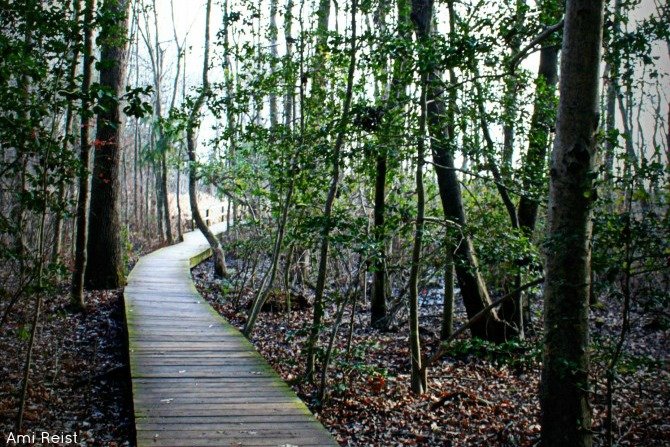On the west side of Salisbury, MD there are 262 acres of land devoted to preserving local ecosystems and history. Weaving through marshlands, forest, woods, and meadows on that acreage there are 4-and-a-half miles of meticulously kept nature trails. The varying landscapes offer sightings of bald eagles, turtles, tiny vireo, deer, and a clear view of the Wicomico River – the historic home, built in 1741, that is centrally located in the park isn’t hard on the eyes either.
All of Pemberton Park has been dedicated to preserving Pemberton Hall, an 18th century plantation home that was saved from eager bulldozers a few decades ago. The Pemberton Hall Foundation saved one of the first established homes in Wicomico County from destruction and opened the estate’s 250+ acres to the public. Isaac and Anne Handy, the couple who built the house in 1741, would be proud to know that their home is being enjoyed by many – including myself.
Over the weekend, I seized an opportunity to explore another new spot on the Eastern Shore. Pemberton was easy to find; it’s located off of Route 50 on Pemberton Drive. My dog (leashed dogs are always welcome at the park) and I elected to walk the longest trail that morning. The Bell trail is estimated to take 45-minutes to complete. Surprisingly, it took my pup and I an hour and fifteen minutes to complete – keep in mind that I often walk off the beaten path, stop to take photos, climb trees, let the dog sniff random clumps of grass, and chit chat with other hikers. If I were to complete the trail solo without pausing every 25 yards, yes, it would have taken me 45 minutes.
Some of the things we stopped to look at? Trees. White pines, southern red oaks, American holly, Atlantic white cedar, sycamores, and loblolly pines – a combination of some favorite trees that are scattered across the shore. I’d consider myself an arbor culturist of sorts. I don’t know anyone else who stashes tree identification books in their vehicle’s center console to identify random trees at stoplights. That must make me an arborist, right?
The forest ground was mushy, a peat composed mixture of fallen pine needles, smashed leaves, and moss. Towering loblolly trees acted as a tall ceiling and created the feeling of walking through a fancy cathedral. One minute we were hoofing it across a hand-made wooden bridge over a reed-filled wetland, the next we were rounding the corner and entering a cleared meadow of brown wild flowers, presumably where the Handy’s cattle once grazed. A few hundred meters later, I walked directly under an immense power-line tower with cables stretched across the brackish Wicomico River. The river was still, the tidal freshwater was grey, and water levels showed that it had rained recently.
The upland pines mixed with the hardwood trees on the next lag of the journey through Pemberton amazed me. I had been walking with my head down, fiddling with my camera settings, when I felt the Labradoodle’s leash pull tight in my right hand. I raised my head to see what she was after, thinking it’d be a squirrel, a bird, or a passerby on the trail. I was surprised to see that she had leapt across a giant fallen tree that was covering the trail.
It wasn’t just any tree; it was a completely uprooted Sycamore tree that was at least 120 feet tall. The mottled exfoliating bark was bright green, grey and brown and a sign that the tree was still alive. I ducked under the trunk and went to take a closer look at the exposed fibrous root system. I was truly humbled by the size of this tree. The roots of a downed loblolly pine, who had surely been blown over by a force of nature, were entwined with those of the giant sycamore. Loblollys have fibrous thin roots because they are accustomed to growing in low, wet places like riverbeds and marshland. Sycamores have thick, dense roots that are meant to support an expansive tree is capable of growing to 30+ feet in circumference. The two trees left an expansive shallow hole in the dark forest bottom and had become tangled in the nearby trees that now supported the bare branches.
Standing next to the giant sycamore was exhilarating. Knowing that something this large and sturdy could be wiped out by a heavy rainstorm, flooded river, or some other natural force is rapturous. I set my camera timer and the dog chased me as I sprinted 20 feet to pose in front of the roots so you, my adventure-loving readers, could see exactly what I had seen. Don’t rely upon one single photo, though, it doesn’t do justice. Go see for yourself.
Pemberton Park offers guests a chance to hike 7 different trails. Each trail has designated markers and attributes: a historical trail, a woodland tour, a visit to a pond, across wetland bridges, past the bald eagle nest, or through osprey breading grounds. Nature enthusiasts will enjoy this park immensely. You’d never suspect something so peaceful, beautiful, and humbling to be found less than 5 minutes west of Salisbury. You may find yourself wandering through the woods for longer than you had originally planned. Cheers to the Friends of Pemberton Park Organization and the Pemberton Hall Foundation for preserving local history and ecosystems.







